Optical and X-Ray Topographic Studies of Dislocations, Growth-Sector Boundaries, and Stacking Faults in Synthetic Diamonds
Abstract
:1. Introduction
2 Diamonds Grown in the [111] Direction—Birefringence Studies
2.1. The Diamond Specimens
2.2. Birefringence Measurements of [111]-Grown Diamonds
2.3. Measurements of Birefringence
2.4. X-Ray Topography of [111]-Grown Diamonds
3. Diamonds Grown in the [001] Direction—Synchrotron X-Radiation Studies
3.1. Optical Studies of [001]-Grown Diamonds
3.2. X-Ray Studies of [001]-Grown Diamonds
3.3. The g.b = 0 Criterion for Invisibility of a Dislocation of Burgers Vector b
4. Diamond Slabs Cut from a Truncated Octahedral Diamond—Characteristic X-Ray Topographic Studies
4.1. Specimen Preparation
4.2. Single-Crystal and Double-Crystal X-Ray Topographic Investigations of Diamond C
4.3. Studies of Dislocations, Inclusions, and Stacking Faults
4.4. Studies of Stacking Faults
5. Conclusions
Acknowledgments
Author Contributions
Conflicts of Interest
References
- Wentorf, R.H., Jr. Some studies of diamond growth rates. J. Phys. Chem. 1971, 75, 1833–1837. [Google Scholar] [CrossRef]
- Strong, H.M.; Wentorf, R.H., Jr. The growth of large diamond crystals. Naturwissenschaften 1972, 59, 1–7. [Google Scholar] [CrossRef]
- Burns, R.C.; Robertson, S.H.; Keddy, R.J.; Nam, T.J. Large synthetic diamonds—Their manufacture and application. In Diamond Conference Abstracts; Royal Holloway and Bedford New College: Surrey, UK, 1986; pp. 18–22. [Google Scholar]
- Lang, A.R. Diffraction and Imaging Techniques in Material Science; Amelinckx, S., Gevers, R., Van Landuyt, J., Eds.; North Holland: Amsterdam, The Netherlands; New York, NY, USA; Oxford, UK, 1978; Volume 2, p. 623. [Google Scholar]
- Lang, A.R. On the growth-sectorial dependence of defects in natural diamonds. Proc. R. Soc. Lond. A 1974, 340, 233–248. [Google Scholar] [CrossRef]
- Hanley, P.L.; Kiflawi, I.; Lang, A.R. On topographically identifiable sources of cathodoluminescence in natural diamonds. Phil. Trans. R. Soc. Lond. A 1977, 284, 329–368. [Google Scholar] [CrossRef]
- Woods, G.S.; Lang, A.R. Cathodoluminescence, optical absorption and X-ray topographic studies of synthetic diamonds. J. Cryst. Growth 1975, 28, 215–226. [Google Scholar] [CrossRef]
- Frank, F.C.; Lang, A.R.; Evans, D.J.F.; Rooney, M.-L.T.; Spear, P.M.; Welbourn, C.M. Orientation-dependent nitrogen incorporation on vicinals on synthetic diamond cube growth surfaces. J. Cryst. Growth 1990, 100, 354–376. [Google Scholar] [CrossRef]
- Lang, A.R.; Moore, M. Cathodoluminescence and X-ray topography of HPHT diamonds. In New Diamond Science and Technology, Proceeding of MRS International Conference, Boston, MA, USA, 2–6 December 1991; 1991; pp. 683–694. [Google Scholar]
- Burns, R.C.; Chumakov, A.J.; Connell, S.H.; Dube, D.; Godfried, H.P.; Hansen, J.O.; Härtwig, J.; Hoszowska, J.; Masiello, F.; Mkhonza, L.; et al. HPHT growth and X-ray characterization of high quality type IIa diamond. J. Phys. Condens. Matter 2009, 21, 364224. [Google Scholar] [CrossRef] [PubMed]
- Martineau, P.M.; Gaukroger, M.P.; Guy, K.B.; Lawson, S.C.; Twitchen, D.J.; Friel, I.; Hausen, J.O.; Summerton, C.G.; Addison, T.P.G.; Burns, R. High crystalline quality single-crystal vapour deposition diamond. J. Phys. Condens. Matter 2009, 21, 364205. [Google Scholar] [CrossRef] [PubMed]
- Lang, A.R.; Moore, M.; Makepeace, A.P.W.; Wierzchowski, W.; Welbourn, C. On the dilatation of synthetic type Ib diamond by substitutional nitrogen impurity. Phil. Trans. R. Soc. Lond. A 1991, 337, 497–520. [Google Scholar] [CrossRef]
- Wierzchowski, W.K.; Moore, M.; Makepeace, A.P.W.; Yacoot, A. X-ray topographic studies and measurement of lattice parameter differences within synthetic diamonds grown by the reconstitution technique. J. Cryst. Growth 1991, 114, 209–227. [Google Scholar] [CrossRef]
- Kowalski, G.; Lang, A.R.; Makepeace, A.P.W.; Moore, M. Studies of stacking-fault contrast by synchrotron X-ray section topography. J. Appl. Cryst. 1989, 22, 410–430. [Google Scholar] [CrossRef]
- Wierzchowski, W.K.; Moore, M. Observation of interference fringes in Bragg-case synchrotron double-crystal images of stacking faults in diamond. Acta Phys. Pol. A 1992, 82, 185–191. [Google Scholar] [CrossRef]
- Wierzchowski, W.K.; Moore, M. The images of dislocations in synchrotron Bragg-case section topography of diamond. Acta Phys. Pol. A 1992, 82, 193–200. [Google Scholar] [CrossRef]
- Wierzchowski, W.; Moore, M. Bragg-case images of stacking faults. Acta Cryst. A 1995, 51, 831–840. [Google Scholar] [CrossRef]
- Kowalski, G.; Moore, M.; Gledhill, G.; Maričić, Z. Synchrotron X-ray studies of strain in (100)-oriented high pressure-high temperature (HP-HT) synthetic diamonds. Diam. Relat. Mater. 1996, 4, 1254–1263. [Google Scholar] [CrossRef]
- Moore, M.; Golshan, M.; Kowalski, G.; Reid, J.; Collins, S.; Murphy, B. Reciprocal-space mapping of synthetic and natural diamond. J. Phys. D Appl. Phys. 1999, 32, A37–A41. [Google Scholar] [CrossRef]
- Moore, M.; Wierzchowski, W. Transmission double-crystal synchrotron studies of synthetic diamond using the Haruta stereo-pairs technique. Phil. Trans. R. Soc. Lond. A 1999, 357, 2671–2679. [Google Scholar] [CrossRef]
- Wierzchowski, W.K.; Moore, M. Bragg-case Kg and K0 beam double-crystal synchrotron studies of growth sectors and dislocations in synthetic diamonds. J. Appl. Phys. 2007, 101, 053518–053526. [Google Scholar] [CrossRef]
- Nailer, S.G.; Moore, M.; Chapman, J.; Kowalski, G. On the role of nitrogen in stiffening the diamond structure. J. Appl. Cryst. 2007, 40, 1146–1152. [Google Scholar] [CrossRef]
- Khokhryakov, A.F.; Palyanov, Y.N. Revealing of dislocations in diamond crystals by the selective etching method. J. Cryst. Growth 2006, 293, 469–474. [Google Scholar] [CrossRef]
- Khokhryakov, A.F.; Palyanov, Y.N. Revealing of planar defects and partial dislocations in large synthetic diamond crystals by the selective etching. J. Cryst. Growth 2007, 306, 458–464. [Google Scholar] [CrossRef]
- Frank, F.C.; Lang, A.R. X-ray topography of diamond. In Physical Properties of Diamond; Berman, R., Ed.; Clarendon Press: Oxford, UK, 1965; pp. 86–102 and 425–426. [Google Scholar]
- Khokhryakov, A.F.; Palyanov, Y.N.; Kuprianov, I. N.; Borzdov, Y.M.; Sokol, A.G.; Härtwig, J.; Masiello, F. Crystal growth and perfection of large octahedral synthetic diamonds. J. Cryst. Growth 2011, 317, 32–38. [Google Scholar] [CrossRef]
- Kasu, M.; Murakami, R.; Masuya, S.; Harada, K.; Sumiya, H. Synchrotron X-ray topography of dislocations in high-pressure high-temperature-grown single crystal diamond with low dislocation density. Appl. Phys. Exp. 2014, 7, 125501. [Google Scholar] [CrossRef]
- Tamasaku, K.; Ueda, T.; Miwa, D.; Ishikawa, D. Goniometric and topographic characterization of synthetic IIa diamonds. J. Phys. D Appl. Phys. 2005, 38, A61–A66. [Google Scholar] [CrossRef]
- Zhong, Y.; Krasnicki, S.; Macrander, A.T.; Chu, Y.S.; Maj, J. Bragg-case limited projection topography study of surface damage in diamond-crystal plates. J. Phys. D Appl. Phys. 2005, 38, A39–A43. [Google Scholar] [CrossRef]
- Gaukroger, M.P.; Martineau, P.M.; Crowder, M.J.; Friel, I.; Williams, S.D.; Twitchen, D.J. X-ray topography studies of dislocations in single crystal CVD diamond. Diam. Relat. Materi. 2008, 17, 262–269. [Google Scholar] [CrossRef]
- Kowalski, G.; Moore, M.; Gledhill, G.; Maričić, Z. Double-crystal diffractometric and topographic studies of (111) oriented synthetic diamonds. J. Phys. D Appl. Phys. 1996, 29, 793–800. [Google Scholar] [CrossRef]
- Glazer, A.M.; Lewis, J.G.; Kaminsky, W. An automatic optical imaging system for birefringent media. Proc. Roy. Soc. Lond. A 1996, 452, 2751–2765. [Google Scholar] [CrossRef]
- Moore, M. Synchrotron X-ray topography. Radiat. Phys. Chem. 1995, 45, 427–444. [Google Scholar] [CrossRef]
- Moore, M. Imaging diamond with X-rays. J. Phys. Condens. Matter 2009, 21, 364217. [Google Scholar] [CrossRef] [PubMed]
- Moore, M. White-beam X-ray topography. Cryst. Rev. 2012, 18, 207–235. [Google Scholar] [CrossRef]
- Lang, A.R. X-ray topographic and optical imaging studies of synthetic diamonds. J. Appl. Cryst. 1994, 27, 988–1001. [Google Scholar] [CrossRef]
- Burns, R.C.; Davies, G.J. Growth of synthetic diamond. In The Properties of Natural and Synthetic Diamond; Field, J.E., Ed.; Academic Press: London, UK, 1992; pp. 395–422. [Google Scholar]
- Burns, R.C.; Cvetkovic, V.; Dodge, C.N.; Evans, D.J.F.; Rooney, T.; Spear, P.M.; Welbourn, C. Growth-sector dependence of optical features in large synthetic diamonds. J. Cryst. Growth. 1990, 104, 257–279. [Google Scholar] [CrossRef]
- Hornstra, J. Dislocations in the diamond lattice. J. Phys. Chem. Solids 1958, 5, 129–141. [Google Scholar] [CrossRef]
- Shaibani, S.J.; Hazzledine, P.M. The displacement and stress fields of a general dislocation close to a free surface of an isotropic solid. Phil. Mag. A 1981, 44, 657–665. [Google Scholar] [CrossRef]
- Agrosi, G.; Nestola, F.; Tempesta, G.; Bruno, M.; Scandale, E.; Harris, J. X-ray topographic study of a diamond from Udachnaya: Implications for the genetic nature of inclusions. Lithos 2016, 248–251, 153–159. [Google Scholar] [CrossRef]
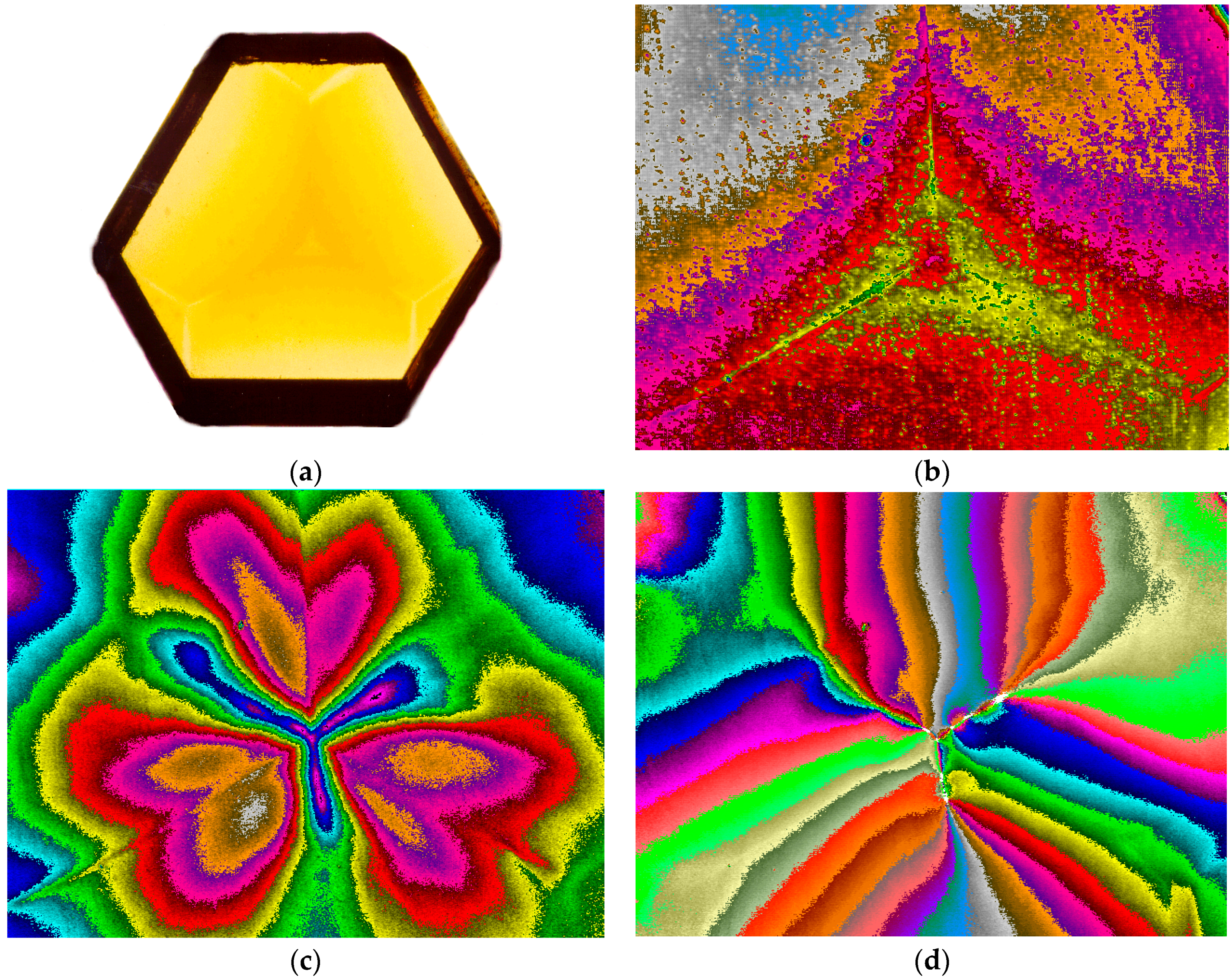

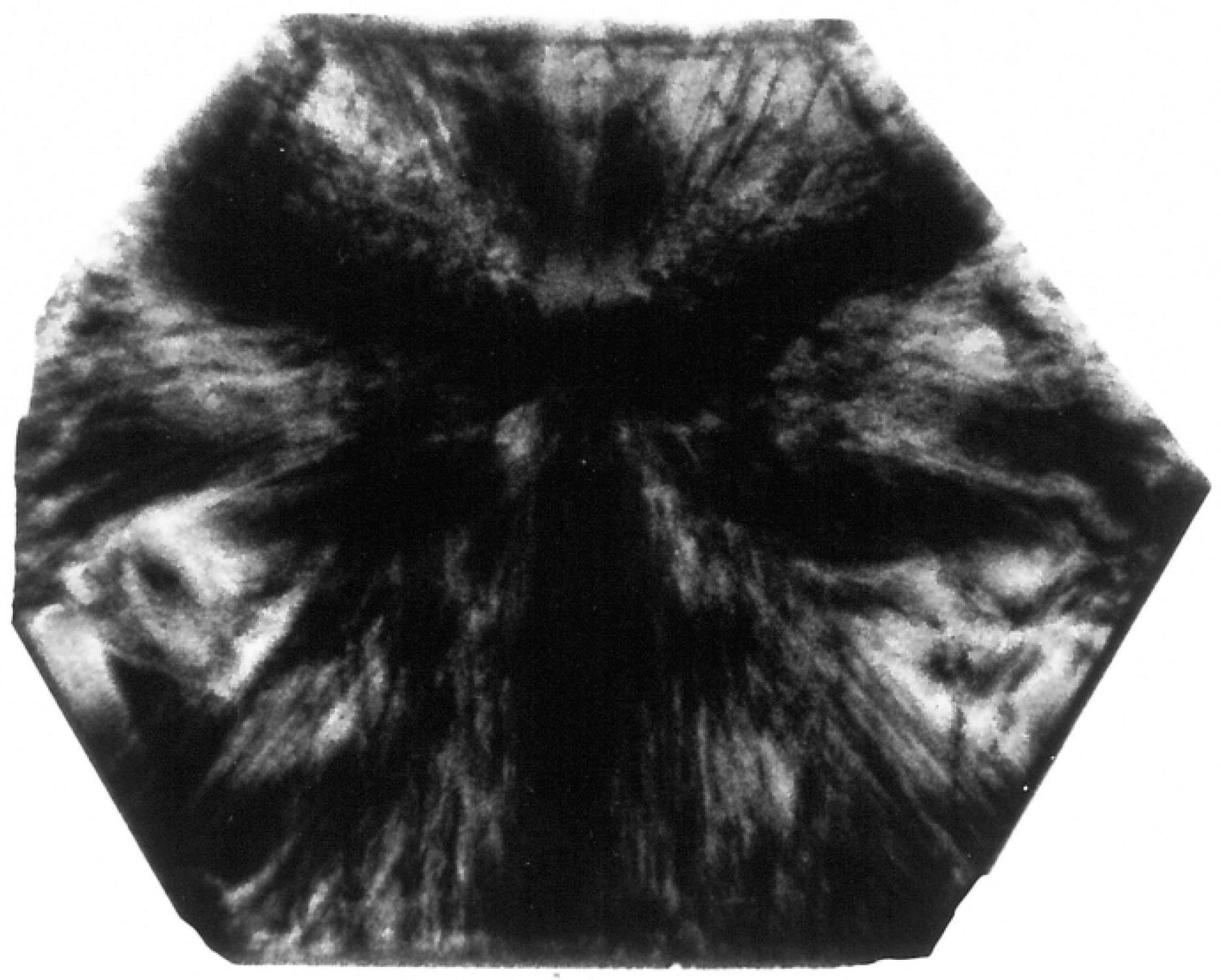
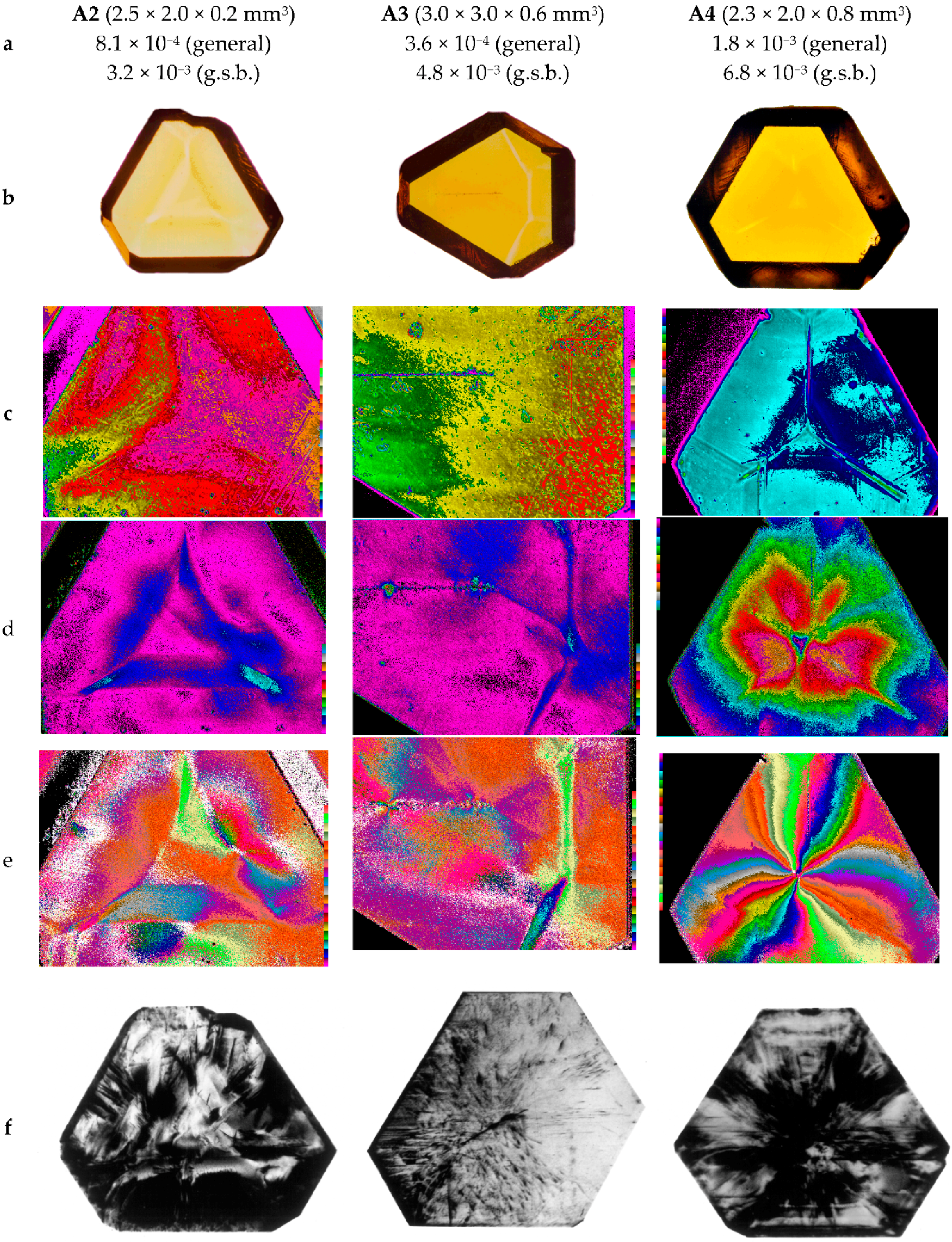
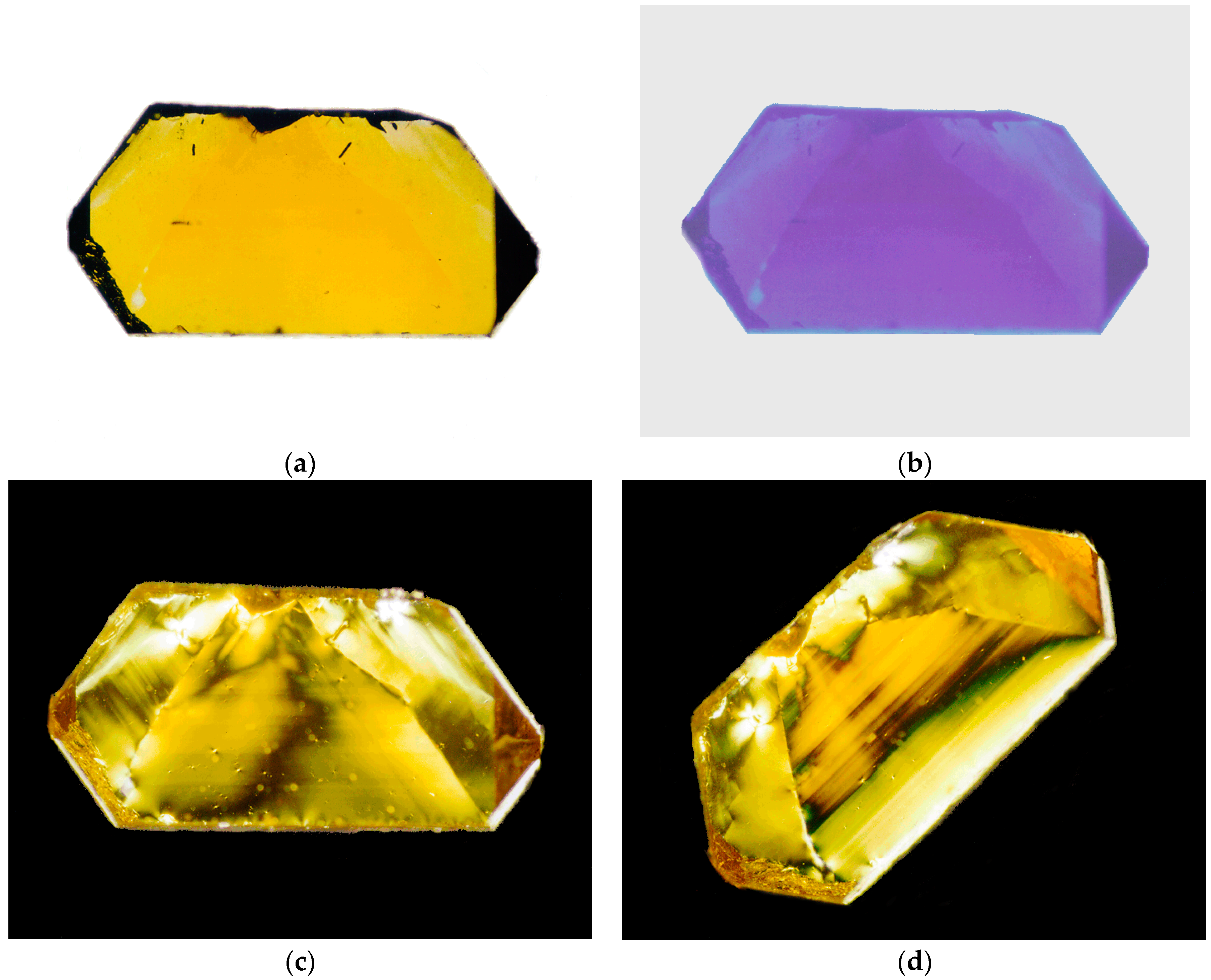


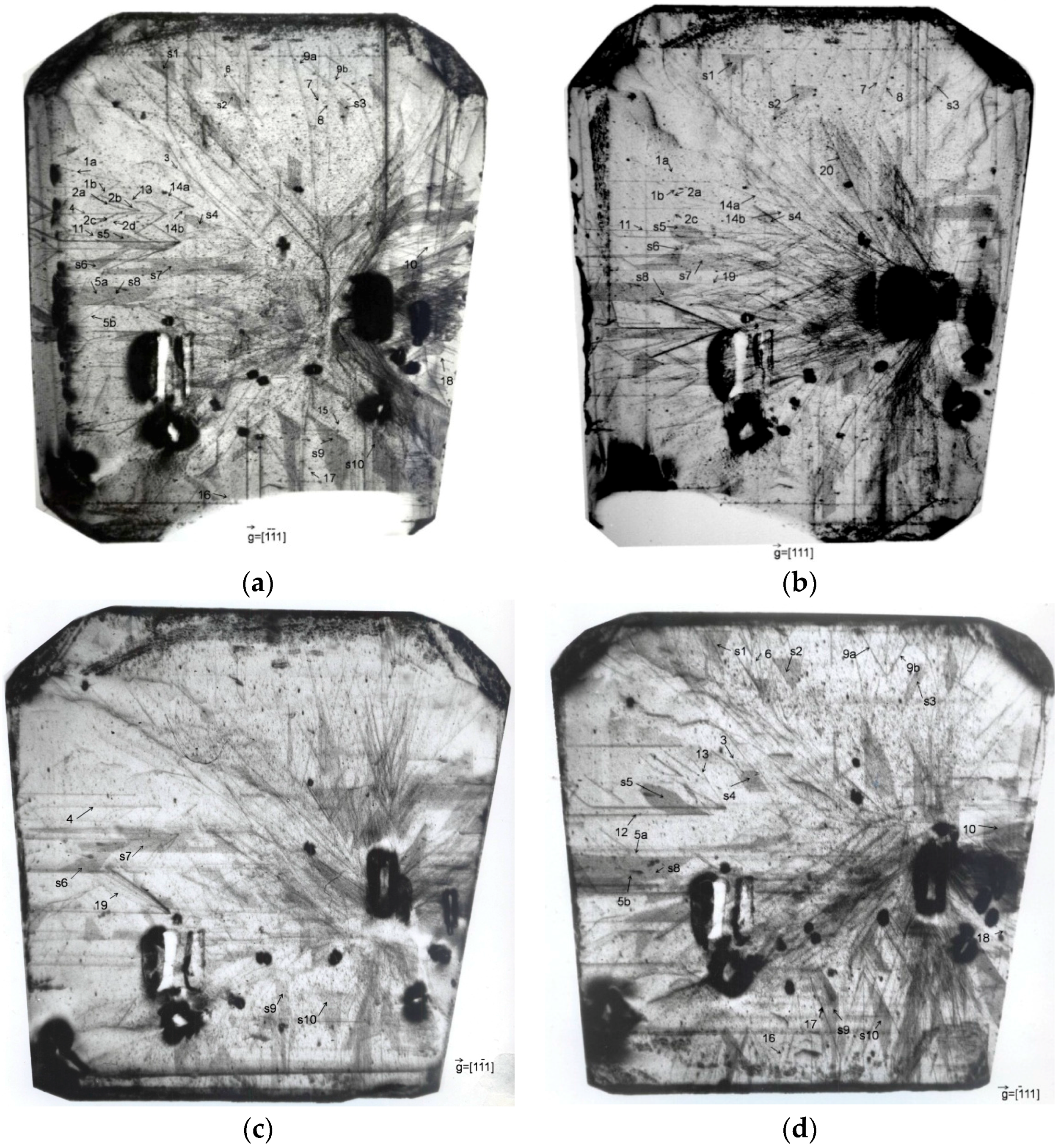
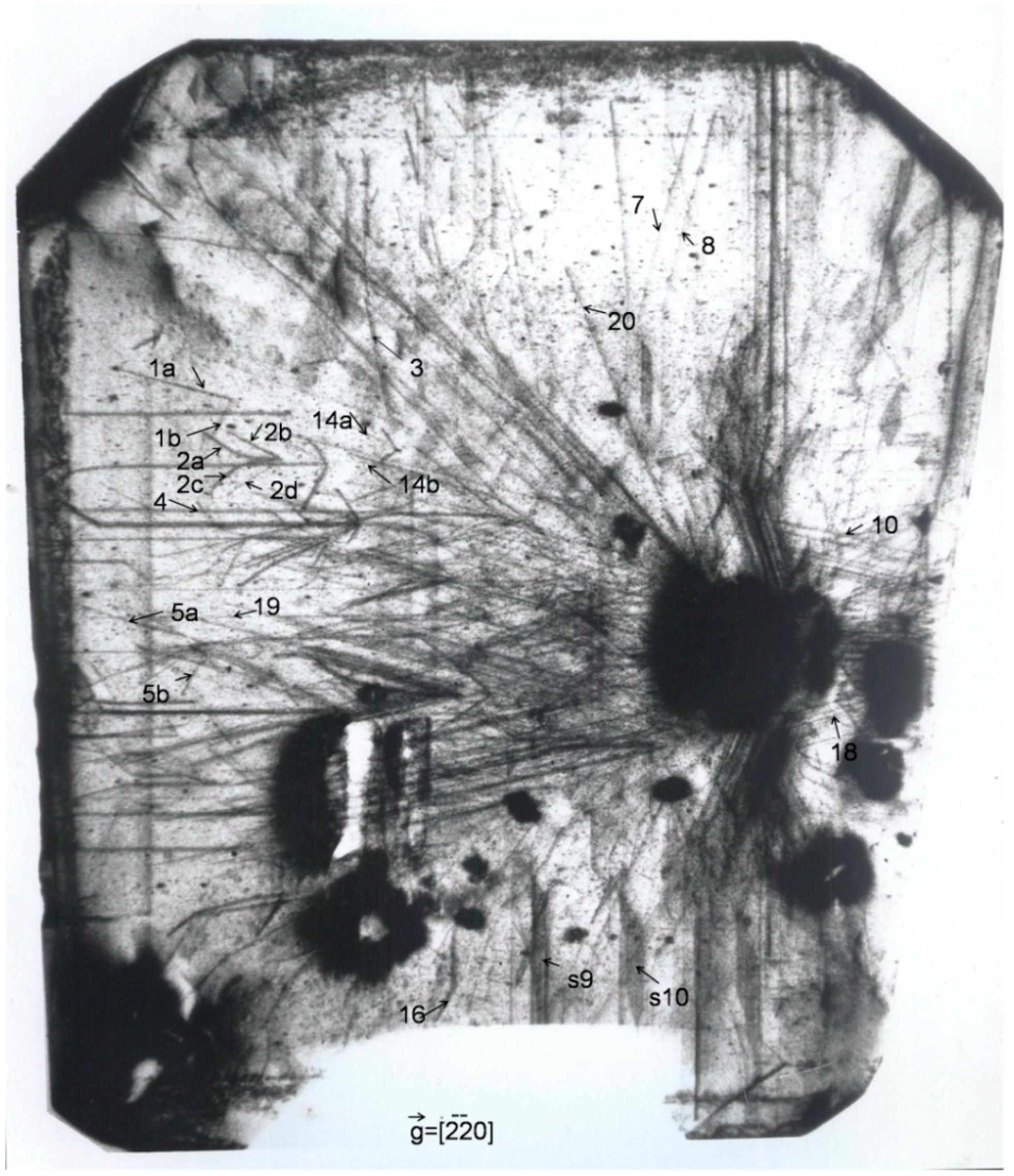
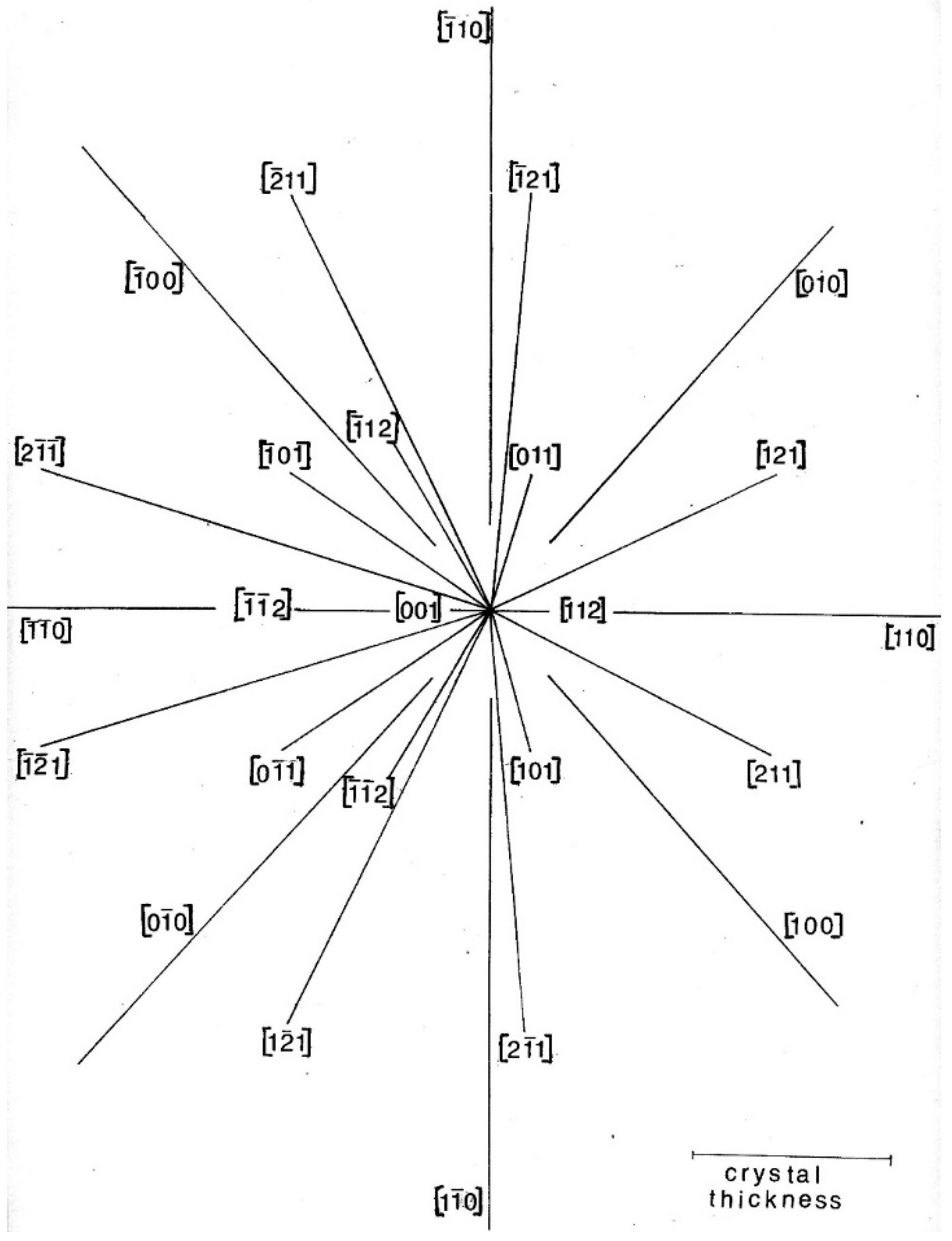

| Reflection | Wavelength (Å) | Bragg Angle θB (°) | Banding Visibility |
|---|---|---|---|
| 111 | 0.66 | 9.20 | I |
| 335 | 0.44 | 23.7 | I |
| 111 | 1.67 | 23.9 | 2 |
| 224 | 0.70 | 28.7 | 2 |
| 337 | 0.47 | 32.7 | I |
| 333 | 0.78 | 34.6 | 2 |
| 335 | 0.68 | 38.4 | 2 |
| 224 | 1.00 | 43.4 | 4 |
| 337 | 0.64 | 47.4 | 4 |
| 115 | 1.02 | 48.2 | 4 |
| 335 | 0.82 | 49.1 | 3 |
| 224 | 1.18 | 54.1 | 4 |
| 337 | 0.74 | 58.1 | 4 |
| 115 | 1.22 | 62.9 | 5 |
| 115 | 1.32 | 73.6 | 5 |
| No. | Direction of Dislocation Line | Direction of Burgers Vector | Dislocation Type |
|---|---|---|---|
| 1a | [110] | 30° | |
| 1b | [110] | 60° | |
| 2a | [110] | 30° | |
| 2b | [110] | 60° | |
| 2c | [110] | 30° | |
| 2d | [110] | 60° | |
| 3 | 30° | ||
| 4 | [110] | 60° | |
| 5a | 30° | ||
| 5b | 60° | ||
| 6 | 30° | ||
| 7 | [110] | 73.2° | |
| 8 | [110] | 73.2° | |
| 9a | screw | ||
| 9b | [011] | 60° | |
| 10 | [121] | edge | |
| 11 | [110] | [110] | screw |
| 12 | [110] | 60° | |
| 13 | [211] | 73.2° | |
| 14a | [211] | [110] | 30° |
| 14b | [110] | 30° | |
| 15 | [110] | 73.2 | |
| 16 | edge | ||
| 17 | edge | ||
| 18 | [211] | 73.2 |
| Number | Fault Plane | Fault Vector |
|---|---|---|
| s1 | or | |
| s2 | or | |
| s3 | or | |
| s4 | or | |
| s5 | or | |
| s6 | or | |
| s7 | or | |
| s8 | or | |
| s9 | (111) | |
| s10 | (111) |
© 2016 by the authors; licensee MDPI, Basel, Switzerland. This article is an open access article distributed under the terms and conditions of the Creative Commons Attribution (CC-BY) license (http://creativecommons.org/licenses/by/4.0/).
Share and Cite
Moore, M.; Nailer, S.G.; Wierzchowski, W.K. Optical and X-Ray Topographic Studies of Dislocations, Growth-Sector Boundaries, and Stacking Faults in Synthetic Diamonds. Crystals 2016, 6, 71. https://doi.org/10.3390/cryst6070071
Moore M, Nailer SG, Wierzchowski WK. Optical and X-Ray Topographic Studies of Dislocations, Growth-Sector Boundaries, and Stacking Faults in Synthetic Diamonds. Crystals. 2016; 6(7):71. https://doi.org/10.3390/cryst6070071
Chicago/Turabian StyleMoore, Moreton, Stuart G. Nailer, and Wojciech K. Wierzchowski. 2016. "Optical and X-Ray Topographic Studies of Dislocations, Growth-Sector Boundaries, and Stacking Faults in Synthetic Diamonds" Crystals 6, no. 7: 71. https://doi.org/10.3390/cryst6070071
APA StyleMoore, M., Nailer, S. G., & Wierzchowski, W. K. (2016). Optical and X-Ray Topographic Studies of Dislocations, Growth-Sector Boundaries, and Stacking Faults in Synthetic Diamonds. Crystals, 6(7), 71. https://doi.org/10.3390/cryst6070071






